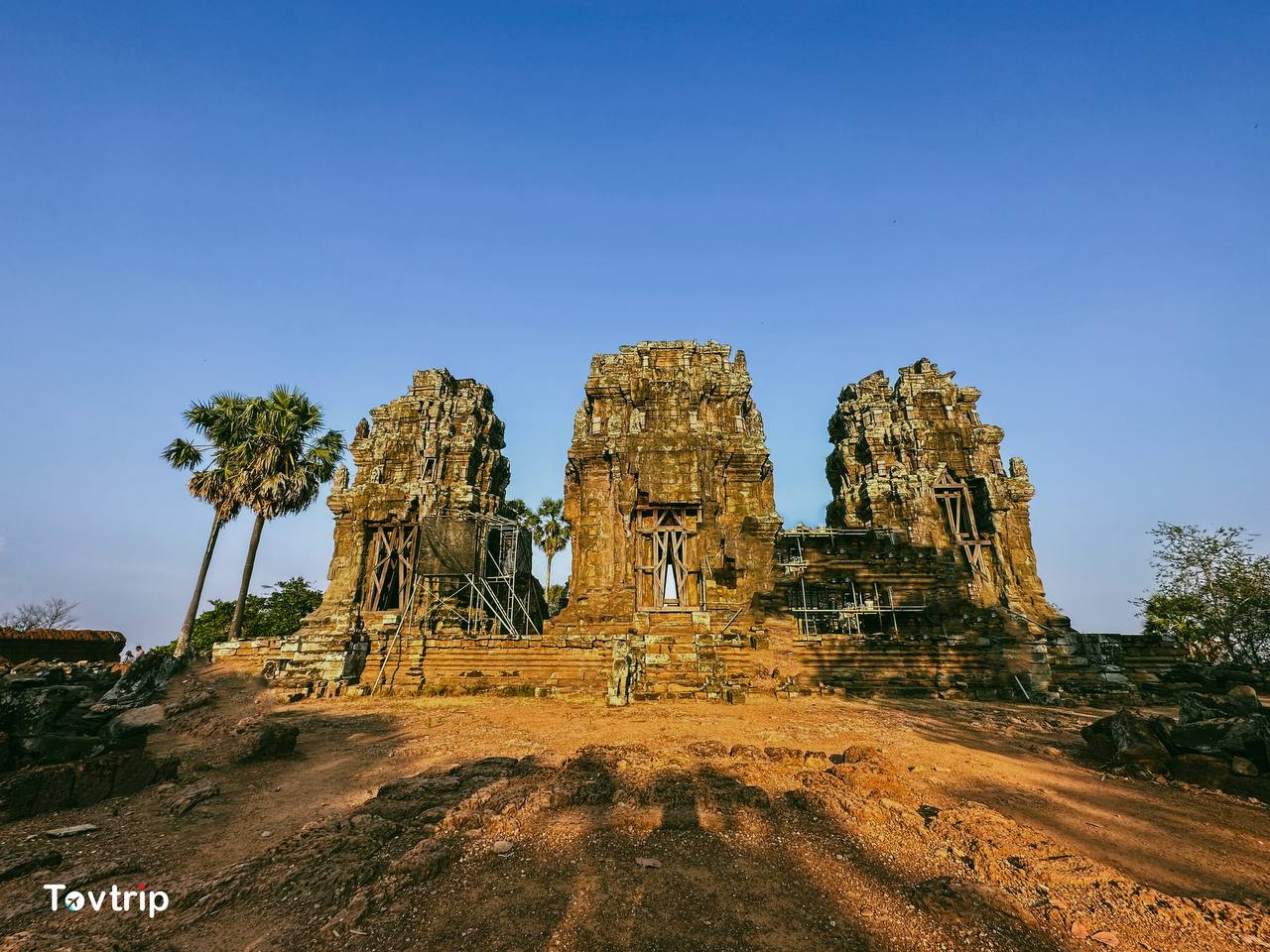
ប្រាសាទភិមានអាកាស (The Phiman Akas Temple)
-
 By
Local-guide N002
By
Local-guide N002
- Date 17 May 2023
ប្រាសាទភិមានអាកាស មានទីតាំងស្ថិតនៅក្នុងភូមិនគរក្រៅ ឃុំគោកចក ស្រុកនគរធំ ខេត្តសៀមរាប។ប្រាសាទភិមានអាកាស សាងសង់នៅដើមសតវត្សទី១១ ក្នុងរជ្ជកាលព្រះបាទជ័យវរ្ម័នទី៥ ជាប្រាសាទមួយដែលកសាងឡើងអំពីថ្មភក់នៅលើជើងគ្រឹះថ្មបាយក្រៀមមានបីជាន់ស្រដៀងនឹងប្រាសាទពីរ៉ាមីដ។ កម្ពស់នៃជើងគ្រឹះប្រាសាទវិមានអាកាសទាំងបីជាន់ប្រហែលជា ១២ម៉ែត្រមានសណ្ឋានជាបួនជ្រុងទ្រវែងមានជណ្តើរចោតទាំងបួនផ្នែក។ចំណែកឯផ្លូវចូលទស្សនាព្រះរាជវាំងត្រូវដើរឆ្លងកាត់ជើងគ្រឹះ ឡើងលើព្រះពន្លាខ្ពស់ទៅតាមជណ្តើរគ្រុឌព្រោះព្រះរាជវាំងនេះតាំងនៅលើព្រះពន្លាខ្ពស់ពេលណាយើងឡើងទៅកាន់ព្រះពន្លានឹងឃើញបដិមាផុសរូបសិង្ហរចនាបថសម័យបាយ័នឈរយ៉ាងអង់អាចនៅក្បាលជណ្តើរទាំងសងខាង។ នៅលើព្រះពន្លានេះនៅមានស្លាកស្នាមការសង់ព្រះពន្លាក្នុងរជ្ជកាលព្រះបាទជ័យវរ្ម័នទី៧ ដែលគេប្រើសម្រាប់រាជការត្រួតពល ឬប្រារព្ធវិធីខាងសាសនាផ្សេងៗ។
The Phiman Akas Temple is situated in the Siem Reap Province's Nokor Thom District, Kork Chak Commune, and Nokor Krao Village. Early in the 11th century, under the reign of King Jayavarman V, the Phiman Akas Temple was constructed. The floor has a pyramidal appearance. The four stairways and rectangular base of the three-story Vimean Akas are around 12 meters high and have a rectangular shape. As for the palace's entry, you must ascend the Garuda stairs through the high pavilion's foundation because the palace is situated there. On both sides at the top of the steps, brave. There are remnants of the pavilion that was built during Jayavarman VII's rule and utilized by the government to oversee or celebrate various religious ceremonies can be seen on this pavilion.
Read More

ប្រាសាទភ្នាគោល (The Phna Koul Temple)
-
 By
Local-guide N002
By
Local-guide N002
- Date 17 May 2023
ប្រាសាទភ្នាគោល មានទីតាំងស្ថិតនៅក្នុងភូមិគោល ឃុំគោល ស្រុកអង្គរជុំ ដែលមានចំងាយប្រមាណជា ៥៨គីឡូម៉ែត្រ ពីទីរួមខេត្តសៀមរាប។ ប្រាសាទនេះត្រូវបានសាងសង់ឡើងនៅស.តទី១០ រាជ្ជកាលព្រះបាទរាជេន្រ្ទវម្ម៍ទី២ និងកសាងដើម្បីការគោរបូជារបស់ប្រជាពលរដ្ឋនៅក្នុងសម័យនោះ។សព្វថ្ងៃប្រាសាទភ្នាគោលជារមណីយដ្ឋានទេសចរណ៍បែបប្រវត្តិសាស្រ្ត នៅទីនេះមានសក្តានុពលទេសចរណ៍សំខាន់ៗយ៉ាងច្រើនដូចជាប្រវត្តិនៃការសាងសង់ ទីតាំងនិងរចនាបទ ភ្ញៀវទេសចរអាចមកសិក្សាអំពីរប្រវត្តិសាស្រ្តលំហែកម្សាន្ត មើលប្រាសាទ មើលចម្លាក់និងថតរូបទុកជាអនុស្សាវរីយ៍។
The Phna Koul Temple is situated around 58 kilometers from Siem Reap in Koul Village, Koul Commune, in the Angkor Chum District. During the reign of King Rajendravam II in the 10th century, this temple was erected for the worship of the populace at that time. Currently, Phana Koul Temple is a significant historical tourist destination with a lot of attractive tourist potential, including the history of construction, location, and style. Tourists can visit to learn about the history, for fun, to admire the temple and its artwork, and to take photos as keepsakes.
Read More

ប្រាសាទភ្នំក្រោម (Phnom Krom Temple)
-
 By
Local-guide N002
By
Local-guide N002
- Date 16 May 2023
ប្រាសាទភ្នំក្រោម មានទីតាំងស្ថិតក្នុងភូមិភ្នំក្រោម ឃុំចុងឃ្នាស ស្រុកសៀមរាប ដែលមានចំងាយប្រមាណជា ១៣គីឡូម៉ែត្រ ពីទីរួមខេត្តសៀមរាប។ ប្រាសាទភ្នំក្រោម ជាកូនភ្នំមួយមានកំពស់១៤០ម៉ែត្រ ត្រូវបានស្ថាបនាឡើងនៅចុងសតវត្សទី៩ និង ដើមសតវត្សទី១០ ដោយព្រះបាទយសោវរ្ម័នទី១ (៨៨៩-៩១៥)គឺដើម្បីឧទ្ទិសដល់អាទិទេពទាំងបីក្នុងព្រហ្មញ្ញសាសនាគឺ ព្រះឥសូរ ព្រះវិស្ណុ និង ព្រះព្រហ្ម។ ប្រាសាទនេះមានប្រាង្គបីធ្វើអំពីថ្មភក់ ស្ថិតនៅជាជួរលើខឿនមួយពីខាងជើងទៅត្បូង។ ប្រាង្គកណ្តាលឧទ្ទិសដល់ព្រះឥសូរ ខាងជើងឧទ្ទិសថ្វាយដល់ព្រះវិស្ណុ និង ខាងត្បូងឧទ្ទិសថ្វាយព្រះព្រហ្ម។ កំពូលនៃប្រាង្គទាំងនេះបានដួលរលំអស់ហើយ។ ប្រាសាទនេះមានកំពែងធ្វើអំពីថ្មបាយក្រៀម និង មានគោបុរៈនៅទិសខាងកើត។
Around 13 kilometers from Siem Reap provincial center, Phnom Krom is situated in Phnom Krom village, Chong Khneas commune, in the Siem Reap district. The three Hindu gods Iso, Vishnu, and Brahma were honored in the 10th century by Yasovarman I (889–915). Three sandstone towers line the temple from north to south. Iso is honored in the center tower, while Vishnu and Brahma are honored in the north and south, respectively. These towers' peaks have already fallen. The gopuras and laterite walls of the temple faced east.
Read More

ប្រាសាទមេបុណ្យខាងកើត (East Mebon Temple)
-
 By
Local-guide N002
By
Local-guide N002
- Date 17 May 2023
ប្រាសាទមេបុណ្យខាងកើត មានទីតាំងស្ថិតនៅចំកណ្តាលបារាយណ៍ខាងកើត ចំងាយប្រហែល ៥០០មែត្រ ពីប្រាសាទប្រែរូប។ប្រាសាទមេបុណ្យខាងកើត គឺហៅសំដៅទៅលើ ប្រាសាទមេបុណ្យមានពីរ មួយគឺមេបុណ្យខាងកើត ស្ថិតនៅបារាយណ៍ខាងកើត និងមួយទៀតមេបុណ្យខាងលិច ស្ថិតនៅកណ្តាលបារាយណ៍ខាងលិច (បារាយណ៍ទឹកថ្លា) ប្រាសាទមេបុណ្យ គឺជាកន្លែងរោងបុណ្យសំរាប់ប្រារព្ធពិធី ដូច្នោះហើយបានជាគេហៅតៗគ្នាថាមេបុណ្យ។ ប្រាសាទនេះបែរមុខទៅទិសខាងកើត និងត្រូវបានសាងសង់នៅសតវត្សទី១០ ក្នុងឆ្នាំ៩៥២ ដោយព្រះបាទរាជេន្ទ្រវរ្ម័នទី១ ដើម្បី ឧទ្ទិសថ្វាយដល់ព្រះឥសូរ ក្នុងព្រហមញ្ញសាសនា។
The Transfiguration Temple is around 500 meters away from the East Mebon Temple, which is situated in the East Bay's core. In the center of the western baray is Mebon West (Teuk Thla baray). King Rajendravarman I erected the temple in the 10th century in 952 to honor Iso in Brahmanism. It faces east.
Read More

ប្រាសាទលលៃ (Prasat Lolay)
-
 By
Local-guide N003
By
Local-guide N003
- Date 17 May 2023
ប្រាសាទលលៃ ស្ថិតនៅខាងជើងផ្លូវជាតិលេខ៦ (សៀមរាប-ភ្នំពេញ)ត្រង់បង្គោល គីឡូម៉ែត្រលេខ១៣ បត់ចុះចម្ងាយ ៥០០ម៉ែត្រពីផ្លូវជាតិ ក្នុងភូមិលលៃ ឃុំប្រាសាទបាគង ស្រុកប្រាសាទបាគង ខេត្តសៀមរាប។ប្រាសាទលលៃ មានតួប៉ម៤ ធ្វើពីឥដ្ឋ សង់រៀងជាពីរជួរមុខក្រោយស្ថិតនៅលើទីទួលខ្ពស់កណ្តាល បារាយណ៍ មានសិលាចារឹកដូចប្រាសាទព្រះគោ បែរមុខទៅទិសខាងកើត ហើយមាន ទ្វារបពោ្ឆតបីទិសទ្វារចូលមួយ នៅលើ មេទ្វារប៉មទាំង៤ មានសិលាចារឹកចារស្មើដៃបៀ្របដូចអក្សរពុម្ព។ ប្រាសាទនេះត្រូវបានប្រជាជននាសម័យក្រោយអង្គរហៅតៗគ្នាមក ប៉ុន្តែឈ្មោះដើមនៃប្រាសាទនេះគឺ ឥស្វរលោក ដែលត្រូវបានកសាងនៅឆ្នាំ៨៩៣ ដោយព្រះបាទយសោវរ្ម័នទី១ ដែលជាបុត្ររបស់ព្រះបាទឥន្ទ្រវរ្ម័នទី១។ ព្រះបាទយសោវរ្ម័នទី១ ឡើងគ្រងរាជបន្តពីព្រះបិតារបស់ព្រះអង្គ ចាប់ពីឆ្នាំ៨៨៩-៩១០នៃគ.ស ហើយបានកសាងប្រាសាទលលៃនៅឆ្នាំ៨៩៣ ដើម្បីឧទ្ទិសដល់ដួងព្រលឹងរបស់ព្រះមាតានិងបិតា ជីដូន និងជីតារបស់ព្រះអង្គ។
At Lolay village, Prasat Bakong commune, Prasat Bakong district, Siem Reap province, Prasat Lolay is situated north of National Route 6 (Siem Reap - Phnom Penh), at the 13th-kilometer marker, turn 500 meters off the national road. The front and back, constructed in two rows, are placed on a tall hill in the midst of the baray. The populace changed the name of this temple during the post-Angkorian era, but its original name was Isvar Lok. King Yasovarman I, the son of King Indravarman I, erected this temple in 893. To honor the souls of his mother, father, grandpa, and grandfather, Yasovarman I built the temple Lolay in 893, succeeding his father from 889 to 910 AD.
Read More
Showing 36 - 40 of 105 posts

